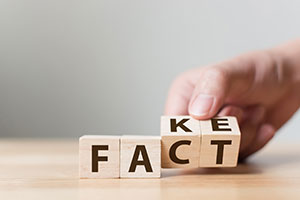Douglas Shaneyfelt was driving at night on a state highway in Ohio. Robert Byram was backing his tractor-trailer into his driveway. Byram’s vehicle was blocking both lanes of traffic when Shaneyfelt began braking. His pickup truck slammed into the side of Byram’s semi.
Byram contended that he was not negligent because he checked the road for oncoming traffic and saw none before he began to back into his driveway. Byram broke no law. Whether it is prudent for a trucker to back into a driveway from a highway at night was a question for the jury. The jury found in favor of Byram.
Shaneyfelt moved for a new trial, contending that he was prejudiced by the computer-simulated images that Byram’s expert witness used as demonstrative evidence. The trial court agreed and granted the motion for a new trial. The Ohio Court of Appeals held that the exhibit was inadmissible but reversed the order for a new trial after finding that the exhibit was not prejudicial.
Demonstrative Evidence
Byram called Ashley Dunn as an accident reconstruction expert. Dunn prepared three computer-simulated images to show how Byram’s truck would have appeared to Shaneyfelt at a distance of 600 feet, 400 feet, and 250 feet.
Shaneyfelt complained that the images were not produced in discovery but were only disclosed four days before trial. The trial court agreed with Shaneyfelt that the untimely production of the images violated the court’s discovery order.
The trial court nevertheless concluded that under Ohio law, discovery violations should not result in the exclusion of evidence unless the violation caused material prejudice to the opposing party. To determine whether the violation was prejudicial, the court allowed the expert to testify, subject to cross-examination.
After the trial, the court determined that the demonstrative exhibits were inadmissible because there was no evidence that they accurately represented Shaneyfelt’s view of the accident. Specifically, Dunn did not measure the brightness of the lights and reflectors on Byram’s tractor-trailer or the brightness of Shaneyfelt’s headlights. Without making that measurement, Dunn could only hazard a guess about how the scene might have appeared to Shaneyfelt.
The court reasoned that Dunn’s demonstrative evidence was “speculative and void of case-specific facts.” Because Dunn’s testimony misrepresented the exhibits as depicting an accurate view of the scene when he could not have known whether the exhibits were accurate, the testimony and related exhibits were prejudicial.
The trial court noted that Byram took a chance by producing the exhibits after the discovery deadline. The court granted a new trial and barred Byram from calling Dunn, or anyone in Dunn’s firm, as an expert witness in further proceedings. Byram appealed.
Appellate Analysis
In the absence of any measurement of headlight brightness, it was impossible to make a demonstrative exhibit that accurately displayed the scene as Shaneyfelt would have seen it. While Dunn relied on industry standards and studies to determine how bright the scene might have been, it is common knowledge that headlights do not always meet industry standards.
Bulbs tend to produce less light as they get older. Perhaps more importantly, dirty or cloudy headlight coverings reduce the brightness of headlights. No assumptions about industry standards can take the place of actual facts when preparing demonstrative evidence.
The court of appeals agreed with Shaneyfelt that the pdf exhibit he received four days before trial differed from the 40” by 30” exhibit that was displayed to the jury. The brightness of the lights in the trial exhibit had been enhanced.
Byram contended that the difference was caused by brightness settings on the printer used to print the pdf. However, the trial exhibit had a car dashboard superimposed over the simulated view that was missing from the pdf. The trial exhibit was obviously not the same exhibit disclosed to Shaneyfelt.
Regardless of the belated pretrial disclosure, the court of appeals agreed that the trial exhibit was inadmissible. Because Dunn did not measure the brightness of the lights shown on the exhibit, the representation of Shaneyfelt’s alleged view was based on speculation, not fact.
The appellate court nevertheless concluded that the improper exhibit was not prejudicial. The court found no evidence in the record that Byram’s decision to back a tractor-trailer into a driveway at night was negligent. The court noted that Shaneyfelt’s own expert agreed that Shaneyfelt’s headlines should have illuminated the truck when Shaneyfelt was 288 feet from the truck. The expert calculated stopping distances and concluded that, if Shaneyfelt had slammed on his brakes at the moment the truck became visible, he could have narrowly avoided the collision.
Lessons Learned
If the trial judge had excluded the exhibit before the jury saw it, there would be no need to guess about the verdict the jury might have returned if it had not been exposed to inadmissible evidence. That is what the judge should have done, although it is not clear that Shaneyfelt objected to the expert’s methodology (as opposed to the belated disclosure) prior to trial.
Demonstrative evidence can be a persuasive tool at trial. Images embed themselves in the minds of jurors more effectively than words. Experts may therefore provide a valuable service for lawyers when they prepare demonstrative exhibits.
But exhibits are evidence, and when they are prepared by experts, they are subject to the same rules of admissibility as other expert evidence. Demonstrative exhibits should have a basis in fact and should reflect the expert’s application of a reasonable methodology.
An exhibit that recreates an accident may be persuasive when an accident reconstruction engineer relies on physics and math to recreate an accident scene. An exhibit that is based on a guess as to how the accident scene might have appeared has no value at all. To assure that demonstrative exhibits are admissible, experts should use the same care when preparing exhibits that they use when preparing reports and formulating opinions.




